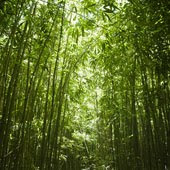FAMILY: Gramineae (Poaceae)
SUBFAMILY: Bambusoideae
TRIBE: Bambuseae
SUBTRIBE: bambusinae
Common names: bamboo
General Description: The plant family, Poaceae, includes various grasses all known as Bamboo. Bambusa vulgaris is the best known, being cultivated and distributed widely. It is a tropical bamboo that grows in clumps and is used for paper production.
Location: These grasses are mostly found in the tropics and in Asia where they are quite diverse.
Bamboo grows from rhizomes and usually in clusters that emerge from the thick trunk underground. This plant enjoys longevity, living from 12 to 120 years, during which it produces seeds only once. The seeds are an edible grain. The young shoots of some of the species may be cooked and consumed as vegetables, particularly in Chinese dishes.
Bamboo is occasionally cultivated; however, it is more commonly found growing in wild and protected areas. It is seen in large stands on alluvial flats, generally near water.
Uses: Bamboo was first identified in Madagascar in 1828; between that date and the first half of the 20th century, a total of 27 species was cataloged. Bamboo contributes significantly to the economy in Madagascar.
Locals use many of the species identified in building fences, making baskets, light construction, musical instruments and water containers. In Benin, Bamboo provides raw material for construction purposes. Bambusa vulgaris is the most common bamboo species growing naturally in the rainforest.
Bamboo is a natural erosion-control plant, very effectively reducing stream and riverbank erosion. However, environmentalists in Benin are concerned about exploiting and destroying rainforests; poor use of the land is a major cause of concern. The need for reforestation needs to be emphasized as much as maintaining and growing the economy.
SUBFAMILY: Bambusoideae
TRIBE: Bambuseae
SUBTRIBE: bambusinae
Common names: bamboo
General Description: The plant family, Poaceae, includes various grasses all known as Bamboo. Bambusa vulgaris is the best known, being cultivated and distributed widely. It is a tropical bamboo that grows in clumps and is used for paper production.
Location: These grasses are mostly found in the tropics and in Asia where they are quite diverse.
Bamboo grows from rhizomes and usually in clusters that emerge from the thick trunk underground. This plant enjoys longevity, living from 12 to 120 years, during which it produces seeds only once. The seeds are an edible grain. The young shoots of some of the species may be cooked and consumed as vegetables, particularly in Chinese dishes.
Bamboo is occasionally cultivated; however, it is more commonly found growing in wild and protected areas. It is seen in large stands on alluvial flats, generally near water.
Uses: Bamboo was first identified in Madagascar in 1828; between that date and the first half of the 20th century, a total of 27 species was cataloged. Bamboo contributes significantly to the economy in Madagascar.
Locals use many of the species identified in building fences, making baskets, light construction, musical instruments and water containers. In Benin, Bamboo provides raw material for construction purposes. Bambusa vulgaris is the most common bamboo species growing naturally in the rainforest.
Bamboo is a natural erosion-control plant, very effectively reducing stream and riverbank erosion. However, environmentalists in Benin are concerned about exploiting and destroying rainforests; poor use of the land is a major cause of concern. The need for reforestation needs to be emphasized as much as maintaining and growing the economy.
http://www.rainforest-plants.blogspot.com
Article Source: http://EzineArticles.com/?expert=Tony_Mandarich


No comments:
Post a Comment